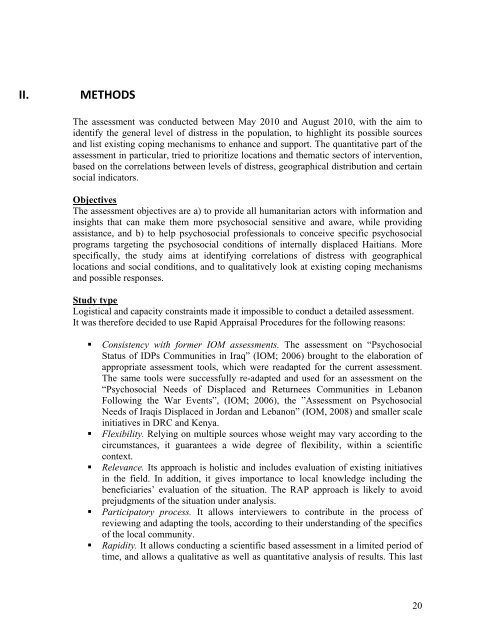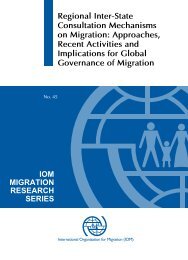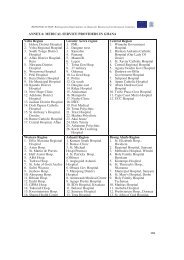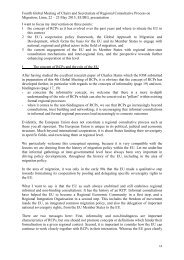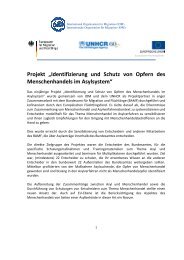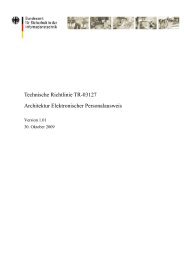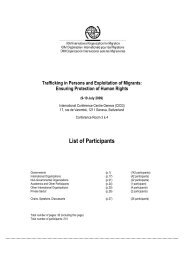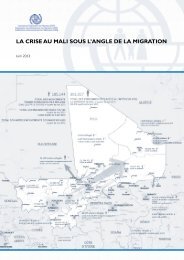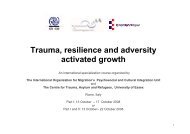IOM - Assessment on the Psychosocial Needs of Haitians Affected ...
IOM - Assessment on the Psychosocial Needs of Haitians Affected ...
IOM - Assessment on the Psychosocial Needs of Haitians Affected ...
You also want an ePaper? Increase the reach of your titles
YUMPU automatically turns print PDFs into web optimized ePapers that Google loves.
II.<br />
METHODS<br />
The assessment was c<strong>on</strong>ducted between May 2010 and August 2010, with <strong>the</strong> aim to<br />
identify <strong>the</strong> general level <strong>of</strong> distress in <strong>the</strong> populati<strong>on</strong>, to highlight its possible sources<br />
and list existing coping mechanisms to enhance and support. The quantitative part <strong>of</strong> <strong>the</strong><br />
assessment in particular, tried to prioritize locati<strong>on</strong>s and <strong>the</strong>matic sectors <strong>of</strong> interventi<strong>on</strong>,<br />
based <strong>on</strong> <strong>the</strong> correlati<strong>on</strong>s between levels <strong>of</strong> distress, geographical distributi<strong>on</strong> and certain<br />
social indicators.<br />
Objectives<br />
The assessment objectives are a) to provide all humanitarian actors with informati<strong>on</strong> and<br />
insights that can make <strong>the</strong>m more psychosocial sensitive and aware, while providing<br />
assistance, and b) to help psychosocial pr<strong>of</strong>essi<strong>on</strong>als to c<strong>on</strong>ceive specific psychosocial<br />
programs targeting <strong>the</strong> psychosocial c<strong>on</strong>diti<strong>on</strong>s <strong>of</strong> internally displaced <strong>Haitians</strong>. More<br />
specifically, <strong>the</strong> study aims at identifying correlati<strong>on</strong>s <strong>of</strong> distress with geographical<br />
locati<strong>on</strong>s and social c<strong>on</strong>diti<strong>on</strong>s, and to qualitatively look at existing coping mechanisms<br />
and possible resp<strong>on</strong>ses.<br />
Study type<br />
Logistical and capacity c<strong>on</strong>straints made it impossible to c<strong>on</strong>duct a detailed assessment.<br />
It was <strong>the</strong>refore decided to use Rapid Appraisal Procedures for <strong>the</strong> following reas<strong>on</strong>s:<br />
• C<strong>on</strong>sistency with former <str<strong>on</strong>g>IOM</str<strong>on</strong>g> assessments. The assessment <strong>on</strong> “<strong>Psychosocial</strong><br />
Status <strong>of</strong> IDPs Communities in Iraq” (<str<strong>on</strong>g>IOM</str<strong>on</strong>g>; 2006) brought to <strong>the</strong> elaborati<strong>on</strong> <strong>of</strong><br />
appropriate assessment tools, which were readapted for <strong>the</strong> current assessment.<br />
The same tools were successfully re-adapted and used for an assessment <strong>on</strong> <strong>the</strong><br />
“<strong>Psychosocial</strong> <strong>Needs</strong> <strong>of</strong> Displaced and Returnees Communities in Leban<strong>on</strong><br />
Following <strong>the</strong> War Events”, (<str<strong>on</strong>g>IOM</str<strong>on</strong>g>; 2006), <strong>the</strong> ”<str<strong>on</strong>g>Assessment</str<strong>on</strong>g> <strong>on</strong> <strong>Psychosocial</strong><br />
<strong>Needs</strong> <strong>of</strong> Iraqis Displaced in Jordan and Leban<strong>on</strong>” (<str<strong>on</strong>g>IOM</str<strong>on</strong>g>, 2008) and smaller scale<br />
initiatives in DRC and Kenya.<br />
• Flexibility. Relying <strong>on</strong> multiple sources whose weight may vary according to <strong>the</strong><br />
circumstances, it guarantees a wide degree <strong>of</strong> flexibility, within a scientific<br />
c<strong>on</strong>text.<br />
• Relevance. Its approach is holistic and includes evaluati<strong>on</strong> <strong>of</strong> existing initiatives<br />
in <strong>the</strong> field. In additi<strong>on</strong>, it gives importance to local knowledge including <strong>the</strong><br />
beneficiaries’ evaluati<strong>on</strong> <strong>of</strong> <strong>the</strong> situati<strong>on</strong>. The RAP approach is likely to avoid<br />
prejudgments <strong>of</strong> <strong>the</strong> situati<strong>on</strong> under analysis.<br />
• Participatory process. It allows interviewers to c<strong>on</strong>tribute in <strong>the</strong> process <strong>of</strong><br />
reviewing and adapting <strong>the</strong> tools, according to <strong>the</strong>ir understanding <strong>of</strong> <strong>the</strong> specifics<br />
<strong>of</strong> <strong>the</strong> local community.<br />
• Rapidity. It allows c<strong>on</strong>ducting a scientific based assessment in a limited period <strong>of</strong><br />
time, and allows a qualitative as well as quantitative analysis <strong>of</strong> results. This last<br />
20


